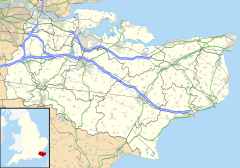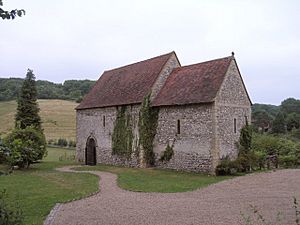Dode, Kent facts for kids
Quick facts for kids Dode |
|
|---|---|
| OS grid reference | TQ6663 |
| District |
|
| Shire county | |
| Region | |
| Country | England |
| Sovereign state | United Kingdom |
| Post town | GRAVESEND |
| Postcode district | DA12 |
| EU Parliament | South East England |
| UK Parliament |
|
| Website | http://www.dodevillage.com/ |
Dode was a small village in England. Sadly, it was completely wiped out by a terrible sickness called the Black Death in 1349. Today, the only building left is its old church. This church was no longer used for worship for a long time, but it was rebuilt in the 1990s.
Contents
Discovering Dode's Past
People have lived in the Dode area for a very long time. We know this because of things found by archaeologists from the time of the Roman Empire.
The church in Dode was built a very long time ago, between 1087 and 1100. This was during the time of King William II of England. The church was built on a small hill made by people. A nearby hill is called "Holly Hill," but its original name was "Holy Hill." The path leading to the village is called "Wrangling Lane." This name suggests the hill might have been a meeting place in the past.
The church is also special because it sits on a straight line, called a ley line, that connects other old places. This line is about 10 miles long and links three churches built before the Protestant Reformation. It also connects two Roman sites, an old Bronze Age burial ground, and two large stone monuments called Medway megaliths – the Coffin Stone and Kit's Coty House.
The Black Death and Dode
The village of Dode was almost completely destroyed by the Black Death. This terrible sickness spread across Europe in the 1300s. The church in Dode was last used for worship in 1367. After that, the Bishop of Rochester, Thomas Trilleck, ordered that it should no longer be used as a church.
Interestingly, Dode's church was originally connected to another old church in Paddlesworth. Stones from Dode's church were even used to help build a new church nearby during the Medieval period.
The Legend of the Dodechild
There's a local story about Dode. It says that the very last person to survive the Black Death in the village was a seven-year-old girl. She is known as the Dodechild. The legend says she hid in the church after everyone else in the village had died. She then passed away inside the church walls. People say the Dodechild's ghost still haunts the churchyard. She is believed to appear on a Sunday morning once a month for several years, and then every seven years.
The Church's New Life
After the Black Death, the village was empty, and the church stood alone for hundreds of years. In 1901, a man named George Matthews Arnold bought the church. He was a collector of old things and also the Mayor of Gravesend. He fixed the church's walls and roof.
In 1954, the Arnold family gave the building back to the Catholic Church. It was given a new name, "The Church of Our Lady of the Meadows." Mass, a religious service, was held there at least once a year.
Over time, the building became damaged again and was even vandalized. But in 1990, a surveyor named Doug Chapman bought the church. He had worked on Canterbury Cathedral. He started to restore the building, at first planning to make it his weekend home. Since 1999, the church has been used as a special place for civil weddings.
The church even made news in December 2009. There was a lot of snow across the country. A bride-to-be called BBC Radio Kent for help. Her wedding transport couldn't get down the narrow lane to Dode because of the snow. Many volunteers came forward with their four-wheel drive cars. They helped transport the wedding party and their guests to the church. After the ceremony, they also took them to a nearby pub in Cobham.



